The Way It Is/ A turbulent, record-setting eraby Gordon Kirby |
 Through the nineteen-seventies the USAC Championship was dominated by the same great drivers who had come to prominence in the sixties--Foyt, Andretti, Bobby and Al Unser, Johnny Rutherford and Gordon Johncock. The top teams were Foyt's operation, Vel's Parnelli Jones, All American Racers, Patrick Racing and new teams in the shape of top road racers Penske and McLaren. Toward the end of the decade Jim Hall's renowned Chaparral team also arrived on the Indy car scene.
Through the nineteen-seventies the USAC Championship was dominated by the same great drivers who had come to prominence in the sixties--Foyt, Andretti, Bobby and Al Unser, Johnny Rutherford and Gordon Johncock. The top teams were Foyt's operation, Vel's Parnelli Jones, All American Racers, Patrick Racing and new teams in the shape of top road racers Penske and McLaren. Toward the end of the decade Jim Hall's renowned Chaparral team also arrived on the Indy car scene.
A.J. Foyt continued to build and race his own cars as he had since the mid-sixties. The Texan also bought the rights to Ford's turbocharged V-8 engine and developed it exclusively for his Coyotes that were designed by Bob Riley. Vel's Parnelli Jones developed its own Ford-powered cars called Colts based on a 1969 Lola and Al Unser won the 1970 and '71 Indy 500s aboard these cars. Unser also won the 1970 USAC championship with teammate Joe Leonard taking the title the next two years. The 1971 Indy 500 proved to be a much tougher race for Unser with serious competition from Mark Donohue in Penske's McLaren-Offy, VPJ teammate Joe Leonard and brother Bobby in AAR's Eagle-Offy. But they all broke, leaving Al to beat Peter Revson in one of the factory McLarens. 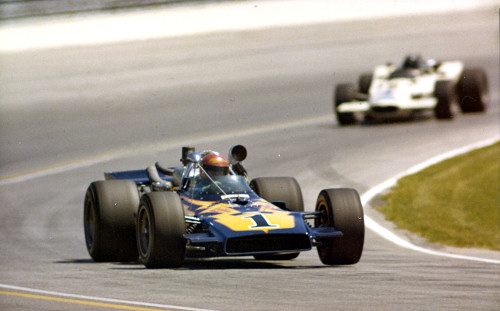 © Racemaker/Torres ~ Al Unser's VPJ Colt in 1971 "We thought we were going to rule the roost again in 1971, but it didn't happen that way," Unser adds. "I won Phoenix, the Speedway and Milwaukee, but after that I never finished another race that year. Things just went to pieces and the car became obsolete overnight. That's technology. The McLarens and then Gurney and Bobby just had us covered. After the middle of '71, everything went wrong. We took the Ford engines out and put Offies in, but nothing went right." Teammate Joe Leonard came through to win the USAC Championship in 1971 and '72. A former motorcycle champion, Leonard started his first Indy 500 in 1965 and joined VPJ in 1968. He scored his first win at Milwaukee in 1970 and won the California 500 in 1971. It was Leonard's only win of the year but by adding two more seconds and one third place to his tally he was able to win the championship comfortably by almost 700 points from A.J. Foyt. The consistent Leonard won the championship again in 1972 and demonstrated his ability by scoring three wins in a row at Michigan, Pocono and Milwaukee in July and August. He also took four more top five finishes to beat Bill Vukovich Jr. to the USAC title by more than 1,200 points. During this time the aerodynamic revolution was well underway at Indianapolis. McLaren raced their successful M16 wedge or wing car for the first time in 1971. McLaren also sold two M16s to Roger Penske and in 1972 Penske Racing scored the first of many Indy 500 wins with Mark Donohue driving a McLaren M16B-Offy. Further developments of the M16 won again with Johnny Rutherford and the factory McLaren team in 1974 and 1976. Dan Gurney and AAR created a similar, side-radiatored challenger to the M16 with the 1972 Eagle while Bob Riley presented a slightly different approach with Foyt's wedge-shaped, Foyt/Ford-powered Coyotes of the early and mid-seventies which featured wide noses and front radiators. In the mid-seventies Riley also designed Pat Patrick's Wildcat-DGS/Offies which were similar in concept to Foyt's cars. 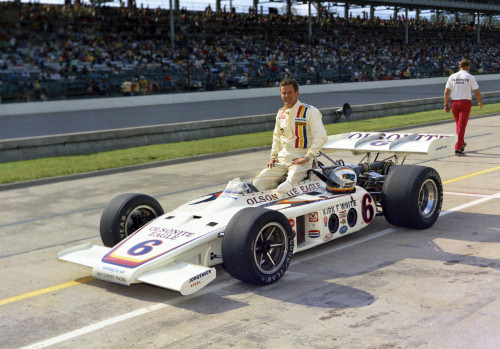 © IMS ~ Bobby Unser's AAR Eagle in 1972 With more than 1,000 bhp on tap for qualifying the sport witnessed the biggest leap in speeds ever seen as Bobby Unser broke the Indianapolis Motor Speedway's track record by eighteen mph in 1972. Later that year Jerry Grant and Unser became the first men to lap a closed circuit at more than 200 mph when they broke the barrier at the Ontario Motor Speedway driving factory AAR Eagles with prodigious amounts of boost. "The '72 Eagle was a great car," Unser grins. "We didn't win the Indy 500 that year but we broke every record there was with that car. It was the first car to run a 200 mph lap and we broke the track record at Indianapolis by 18 mph that year, the biggest jump in speed ever in the history of the Speedway. We had pole after pole after pole with that car. "Roman Slobodynskyj designed the '72 Eagle but a lot of it was Dan Gurney's ideas. Dan really understood the concept and we developed that car together. A lot of my ideas went into that car but Dan was at the top of his game in those days. All American Racers built some good cars through the late sixties and in the seventies. They were good cars, beautifully built, and the '72 Eagle was one of the most successful cars in my career. "The '72 Eagle was way ahead of its time and we had some tricks with the turbocharger that allowed us to make a lot of power. We learned how to make the power and the downforce too and it took everyone else a few years to figure out what we were doing. When Dan came up with the Gurney flap it turned that car from a good car into a great car. With the Gurney flap it just screamed for more horsepower. Give me more horsepower, it said. I can handle it. That car was bloody fast! "We developed and raced that car through four or five years and I finally won at the Speedway with Dan in 1975. For a few years everybody bought Eagles. One year, I think there were 25 Eagles in the field at Indianapolis." 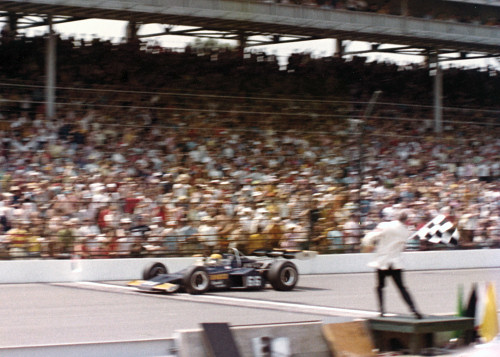 © Dennis Torres ~ Donohue scoring Penske's first win in 1972 The next year's Indianapolis 500 was probably the most tragic and difficult in the race's history. A multi-car accident at the start left Salt Walther with serious burns and resulted in injuries to thirteen spectators. Persistent rain then delayed the race until Wednesday and more rain brought the race to a merciful end with only 133 laps completed after Swede Savage was seriously burned when he crashed heavily in the fourth turn. Armando Teran, a crewman for one of Savage's teammates, was killed when he was hit by an emergency truck rushing up the pitlane in the wrong direction towards Savage's burning wreck. Savage died a month later from his grievous burns. Savage and Teran were employed by oilman Pat Patrick's STP team and Patrick's lead driver Gordon Johncock won the shortened race driving an Eagle-Offy but there were no victory celebrations that year. USAC soon mandated new rules aimed at improving safety. Onboard fuel capacity was cut in half, the size of the giant wings developed over the early seventies was reduced and turbo boost was limited to 80 inches of Mercury. Savage and Walther's accidents also spurred Goodyear to develop a foam-filled rubber fuel cell based on a fuel tank it had designed for military helicopters. Veteran Roger McCluskey won USAC's 1973 championship driving a McLaren-Offy for Lindsey Hopkins. McCluskey made his first Indy 500 start in 1961 and ran most USAC races through the sixties and seventies. He won races at Langhorne in 1966 and Springfield two years later and in 1972 he won the California 500 with Hopkins' team. McCluskey took USAC's 1973 championship by winning at Michigan in July and recording a trio of second places at Milwaukee, Pocono and in the California 500. He thus beat Wally Dallenbach and Johnny Rutherford to the title by more than 1,000 points. Rutherford joined McLaren's USAC team in 1973 and led the team through 1979. He won the Indy 500 two times with McLaren in 1974 and '76 and a third time with Jim Hall's Chaparral in 1980. Rutherford cut his teeth in the late fifties aboard modifieds at the legendary Devil's Bowl Speedway dirt track in Texas before making his reputation in sprint cars, winning USAC's national sprint car championship in 1965 when that form of racing was at its zenith. In 1966 Rutherford broke both arms when he crashed a sprint car at the high-banked Eldora dirt track in Ohio. A rock struck him square in the face, knocking him out and causing a huge shunt which left Rutherford sidelined for twelve months. Another accident in an Indy car at Phoenix in 1968 badly burned both his hands yet he was back in action at Indianapolis the following month. Rutherford began to make his mark in Indy cars when he joined oilman Pat Patrick's team in 1969. He drove for Patrick for four years, then got his big break in 1973 when Teddy Mayer hired him to drive McLaren's lone entry in all the USAC Championship races. Peter Revson partnered Rutherford in a second factory McLaren for the three 500-mile races and after fifteen years of racing and ten years in Indy cars the 35-year old Rutherford's career finally took off. Over the next seven years he would win two Indy 500s, sixteen more races and finish second in the USAC championship in 1974, '75 and '76. 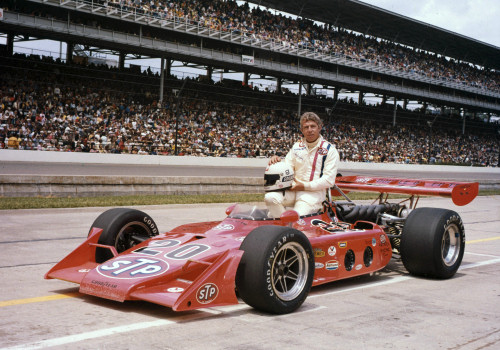 © IMS ~ Johncock's STP Eagle in 1973 "It was a great era and a fun time for drivers and mechanics because we set our own cars up," Rutherford adds. "The drivers and our chief mechanics were the guys who figured-out what springs to change and where to put the weight. It was a little more dangerous, a little more heartbreak occasionally when somebody would get killed. But nobody pointed a gun to our heads and said get in that thing, go out there and take your chances. It was because we loved it and wanted to do it." Those were days of huge horsepower in Indy car racing as turbocharging blossomed. There was also plenty of downforce from big rear wings and lap times skyrocketed through 1971, '72 and '73. Over the course of the seventies and into the eighties ever more restrictions were placed on turbo boost, wings and aerodynamics in general, ultimately resulting in today's much-reduced Indy car. The big-boost, four-cylinder Offy turbos from those days were a beast to drive as the power came on crudely with a great wallop. "Roger Bailey built us an engine for qualifying in 1973 and it was a fire-breather," Rutherford recalls. "It was over 1,000 hp, for sure. I've been told it was lot more than that. Back then we weren't limited on the boost. We used 120 inches manifold pressure in qualifying. The gauge was pegged and bending the needle! In 1973, we turned four laps in practice at over 200 mph with that car and we set a new track record in qualifying at more than 198 mph. It was a treat to drive." Rutherford was quick everywhere in 1973 and finally scored his first win for McLaren at the end of August at the Ontario Motor Speedway in California. He won again on the high-banked Michigan oval in September. At Indianapolis in 1974 Rutherford blew an engine and missed his first qualifying attempt. He turned in the second fastest qualifying run but was deemed a third day qualifier and had to start the 500 from twenty-fifth on the grid. Through the opening laps Rutherford put on a stunning display as he passed car after car around the outside. After passing Bobby Unser's AAR Eagle, Rutherford engaged in a long battle for more than half the race with A.J. Foyt. But with 150 miles to go Foyt pulled in with oil leaking from a broken fitting, his race run. 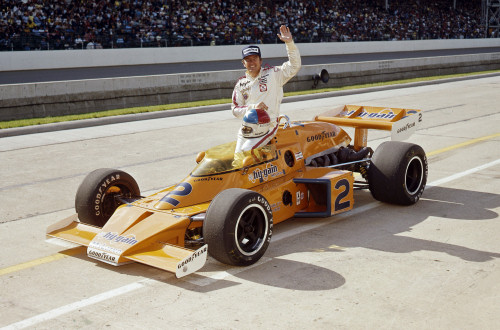 © IMS ~ Rutherford's McLaren M16C in 1974 The 1974 USAC Championship was taken by Bobby Unser who beat Rutherford by more than one thousand points, 4,870 to Rutherford's 3,650. Both won four races that year but Unser came second five times while Rutherford had no other top three finishes. Rutherford was a serious contender to win again at Indy in 1975, but heavy rain with twenty-six laps to go brought the 500 to an early end. He had to settle for second behind Bobby Unser and ahead of Foyt. "In '75, circumstances went against us," Rutherford says. "If it hadn't rained we'd have won and I would have been the first three-in-a-row winner and a four-time winner as well. But that's the way it goes. That's racing." Unser finally was able to win the 500 for All American Racers in 1975. Bobby failed to finish at Indy in 1972 (broken ignition rotor) and '73 (blown engine), and was second to Rutherford in '74. Rutherford believes he would have caught and passed Unser if the final laps had been run in 1975 but Bobby strongly disagrees. "Rutherford always says he was going to catch me in '75," Bobby says. "But I had made my last pitstop and (engine man) John Miller had put some boost in on the pitstop. After that, I could have passed Rutherford in the short chutes. He is so full of shit saying he could have passed me." Team boss Dan Gurney wouldn't let Unser have an onboard boost control knob because he worried that Bobby would run his engine too hard. It was the only race Unser won that year as he blew engines in race after race. At the end of 1975 Unser and Gurney parted ways. Bobby took an Eagle and most of his crew to Bob Fletcher's Cobre Tire team for 1976 and '77, then returned to AAR in '78 for a frustrating year with a new Eagle-Cosworth. "Dan Gurney is still one of the biggest things that happened in my career and one of the smartest guys I've ever met in motor racing," Bobby remarks. "But Dan and I weren't getting along. Both of us are very independent-minded people and we were arguing too much so we went our own ways." 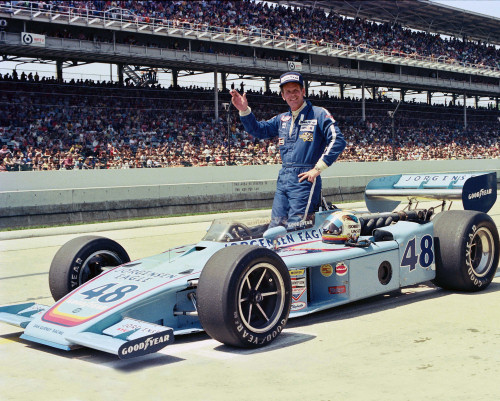 © IMS ~ Bobby Unser's AAR Eagle in 1975 In 1976 Rutherford qualified on the pole at Indianapolis and won the race for a second time with McLaren after another battle with Foyt. The race was stopped short again by rain with Foyt finishing second and Gordon Johncock third. Rutherford's second win marked the fifth straight win at Indianapolis for a turbo Offy-powered car. It also proved to be the last Indy win for an Offy engine. Rutherford was beaten to that year's USAC championship by Johncock aboard one of Pat Patrick's Wildcat-DGS/Offies. Johncock won two races at Michigan and Trenton and had a great record of six seconds and three third places, thus beating Rutherford to the championship by just 20 points with 4,240 points to Rutherford 4,220. In 1977 Foyt scored his long-sought fourth Indy 500 win aboard his Riley-designed Coyote-turbo Foyt/Ford. After his third win at Indy in 1967 Foyt encountered a long fallow period at the Speedway. A new Coyote was designed by Bob Riley in 1973 and with his own turbocharged Foyt/Ford V-8s, Foyt was on the pole at Indianapolis in 1974 and '75. He won seven races and took his sixth USAC championship in 1975, but his fourth Indy victory remained elusive. "In 1975, '76 and '77 nobody could run close with us," A.J. recalls. "In '75 I ran second or third, real strong, and I had to pull it in. We ran second or third and ran out of gas in '76, and in '77 I felt like I had it won easy and I ran out of fuel again! I said, 'Man, am I ever going to win it four times?'. "The '77 race was a great race all day long," he continues. "At that time they didn't have yellow flags and I ran out of fuel and got thirty-two seconds down on Johncock in George Bignotti's car. I started picking him up by two, two and a half seconds a lap. I told (chief mechanic) Little Jack (Starne) that I was going to turn the boost up when we got a little closer because I didn't want to take a chance on blowing the motor up. It was our own car and our own motor and I knew about what it could stand in boost. "As I was closing down on Johncock I knew that Bignotti would let me get to within about ten seconds of him and then he would send Johncock on. I drove for Bignotti and I knew he wasn't going to let me get any closer than that. So it got down to ten seconds and Jack said, 'Have you turned the boost up yet?' I said, 'No, not yet.' And it got to nine, eight, then seven seconds, and I said, 'They've got to be in trouble.' And right there, Johncock blew up." 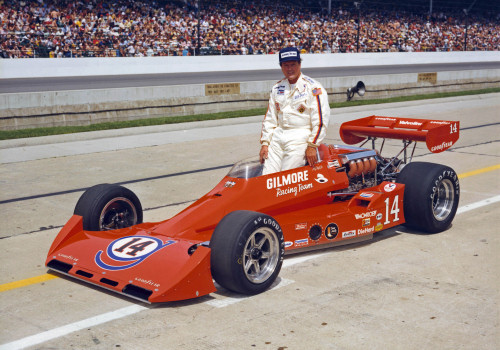 © IMS ~ Foyt and his Coyote in 1977 "You had a lot of power and not nearly the downforce you have now, but still you qualified at over 200 mph," Foyt observes. "People don't realize today what it was like. These boys today don't know how hard those cars were to drive. You didn't have near the equipment they have today, but you were running almost as fast." Foyt also believes those were Indy car racing's greatest days from a purely sporting perspective with open competition among car and engine builders and tire companies. "You could build your own car and you could run for Firestone or Goodyear," A.J. remarks. "You could do whatever you wanted. I always liked it when you controlled your own motor situation even though you blew up a lot more motors than you do today. But today, you're in somebody else's hands. There's no way you could build your own stuff and compete with Honda or Chevrolet." But by 1977 the dominance of the Offy and Foyt/Ford engines was fast coming to an end. VPJ had built and raced a Formula 1 car for Mario Andretti in 1974 and '75 and Parnelli Jones saw Indy car racing's future in the F1 car's Cosworth DFV V8. After getting fed-up with the increasingly bad reliability of the big-boost, turbocharged Offies, Parnelli decided to build and develop the turbo Cosworth DFX engine. It was smaller and more compact than Foyt's stock block-based Ford V8 engine and the now ancient Offy four-cylinder and also suited USAC's new boost-restricted rules. Next week, I'll take a look at the Cosworth revolution spawned by Parnelli and its transformative effect on Indy car racing through the late seventies and eighties. |
|
Auto Racing ~ Gordon Kirby
Copyright ~ All Rights Reserved |
